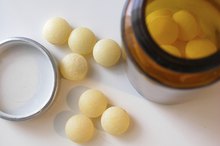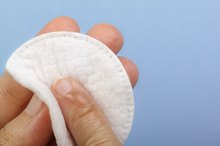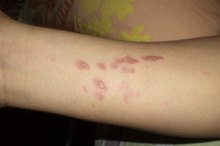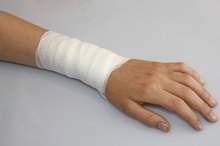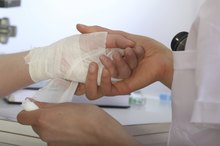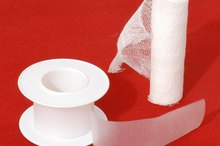How to Accelerate Skin Growth for Burn Wounds
If you expose your skin to high heat, such as a boiling pot of water or a hot automobile part on your car, your skin may become burned and leave you with a painful, tender wound. Your skin will naturally heal itself over time, but the proper after-care and treatment can help accelerate healing and skin re-growth.
Evaluate the seriousness of the burn. First-degree burns cause redness and pain and are treatable at home. Second-degree burns create blisters and can be treatable at home, although the University of Maryland Medical Center recommends seeing a doctor 2. Third-degree burns, which leave your skin pale, leathery or looking charred, should only be treated by an emergency medical professional.
How to Heal Skin Burns With Vitamin Supplements
Learn More
Fill a dish or tub with cold water and soak your burn for 15 minutes, advises the American Medical Association’s first aid handbook 1.
Remove the burned area from the water and gently pat it dry with a clean cloth. Do not rub the burn with the towel.
How to Treat Grass Skin Burn Marks
Learn More
Smooth on an antibiotic ointment or cream and loosely wrap a gauze bandage around the area, according to the American Medical Association. Change the bandage every day until the burn is healed.
Eat high-protein, high-calorie foods, recommends the University of Michigan Health System, to accelerate the healing of your wounds. Suggested foods include beans, meat, peanut butter, fish and eggs.
Drink a lot of water, which your body needs to combat infection and replenish its tissues. The University of Maryland Medical Center reports that burn wound victims should drink a minimum of six glasses of water every day 2.
Use the burned parts of your body normally as much as you can, suggests the University of Michigan Health System. This enhances healing by keeping blood circulating through the area, and also helps to keep the area from becoming stiff.
Take antioxidants vitamin E and vitamin C. The University of Maryland Medical Center notes that these vitamins enhance skin re-growth so your burn heals faster 2. Take 1,000 mg of vitamin C twice a day, and 400 IU of vitamin E daily.
Tips
First degree burns typically heal within six days while second-degree burns usually heal within three weeks, according to the American Medical Association.
If you want help with dealing with the burn pain, the American Medical Association suggests taking a naproxen, ibuprofen or acetaminophen tablet. The association states that the latter two will also help reduce swelling.
Warnings
Wash your hands before changing your bandages.
Never pop any blisters that may form around the burn area.
Related Articles
References
- "American Medical Association Handbook of First Aid and Emergency Care"; American Medical Association; 2009
- University of Maryland Medical Center: Burns
- Princeton University Health Services: Skin Care
- Rowan MP, Cancio LC, Elster EA, et al. Burn wound healing and treatment: review and advancements. Crit Care. 2015;19:243. doi:10.1186/s13054-015-0961-2
- Maenthaisong R, Chaiyakunapruk N, Niruntraporn S, Kongkaew C. The efficacy of aloe vera used for burn wound healing: a systematic review. Burns. 2007;33(6):713-8. doi:10.1016/j.burns.2006.10.384
- The New Zealand Medical Journal. Honey in the treatment of burns: a systematic review and meta-analysis of its efficacy. Published May 22, 2009
- Al-waili N, Salom K, Al-ghamdi AA. Honey for wound healing, ulcers, and burns; data supporting its use in clinical practice. ScientificWorldJournal. 2011;11:766-87. doi:10.1100/tsw.2011.78
- Chandran PK, Kuttan R. Effect of Calendula officinalis Flower Extract on Acute Phase Proteins, Antioxidant Defense Mechanism and Granuloma Formation During Thermal Burns. J Clin Biochem Nutr. 2008;43(2):58–64. doi:10.3164/jcbn.2008043
- Al-Waili N, Salom K, Al-Ghamdi AA. "Honey for wound healing, ulcers, and burns; data supporting its use in clinical practice." ScientificWorldJournal. 2011 Apr 5;11:766-87.
- American Academy of Family Physicians. "First Aid: Burns". December 2010.
- Boukraâ L, Sulaiman SA. "Honey use in burn management: potentials and limitations." Forsch Komplementmed. 2010 Apr;17(2):74-80.
- Chandran PK, Kuttan R. "Effect of Calendula officinalis Flower Extract on Acute Phase Proteins, Antioxidant Defense Mechanism and Granuloma Formation During Thermal Burns." J Clin Biochem Nutr. 2008 Sep;43(2):58-64.
- Maenthaisong R, Chaiyakunapruk N, Niruntraporn S, Kongkaew C. "The efficacy of aloe vera used for burn wound healing: a systematic review." Burns. 2007 Sep;33(6):713-8.
- Molan PC. "Potential of honey in the treatment of wounds and burns." Am J Clin Dermatol. 2001;2(1):13-9.
Writer Bio
Joshua Duvauchelle is a certified personal trainer and health journalist, relationships expert and gardening specialist. His articles and advice have appeared in dozens of magazines, including exercise workouts in Shape, relationship guides for Alive and lifestyle tips for Lifehacker. In his spare time, he enjoys yoga and urban patio gardening.
